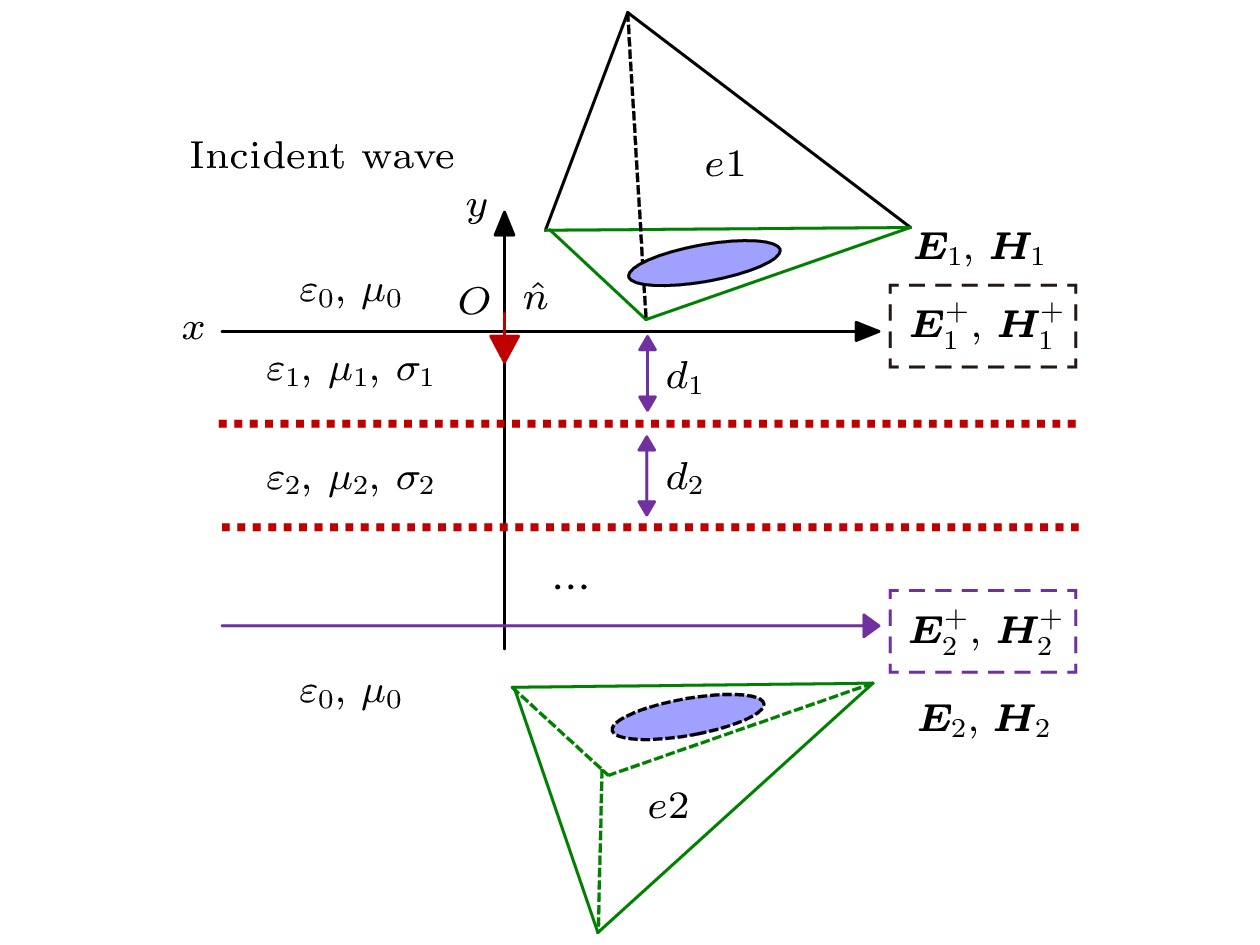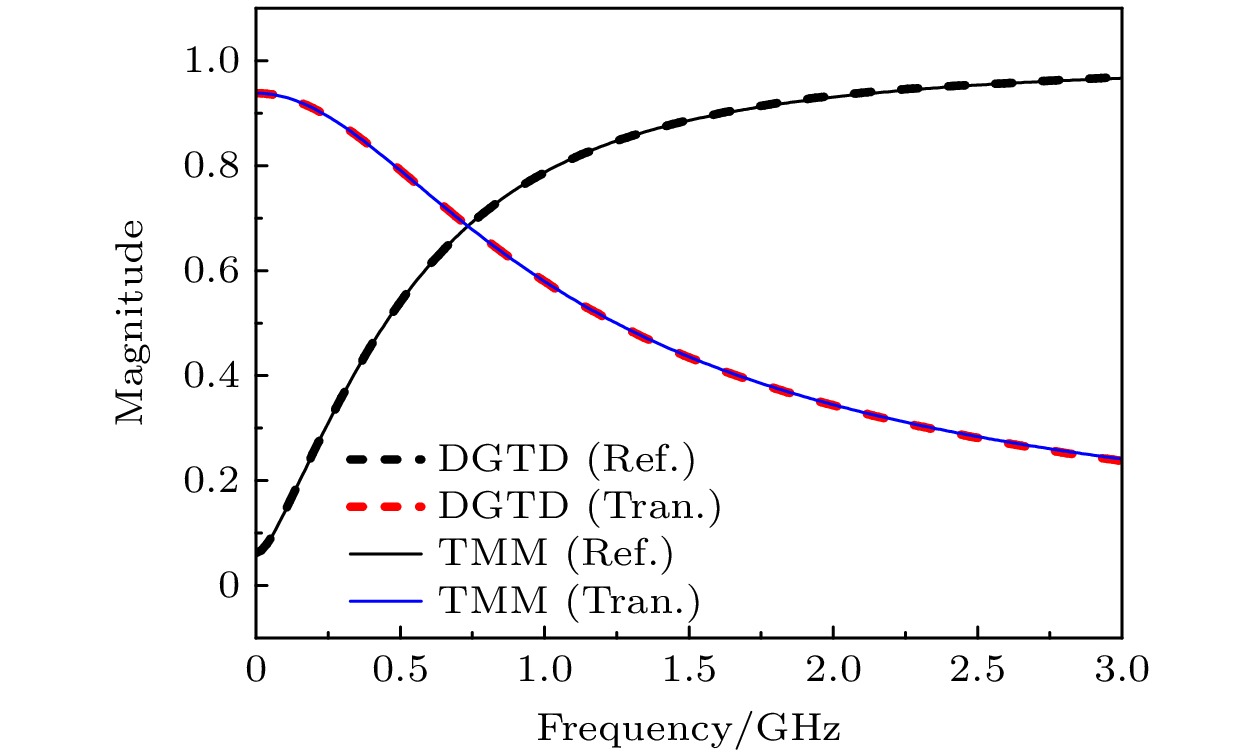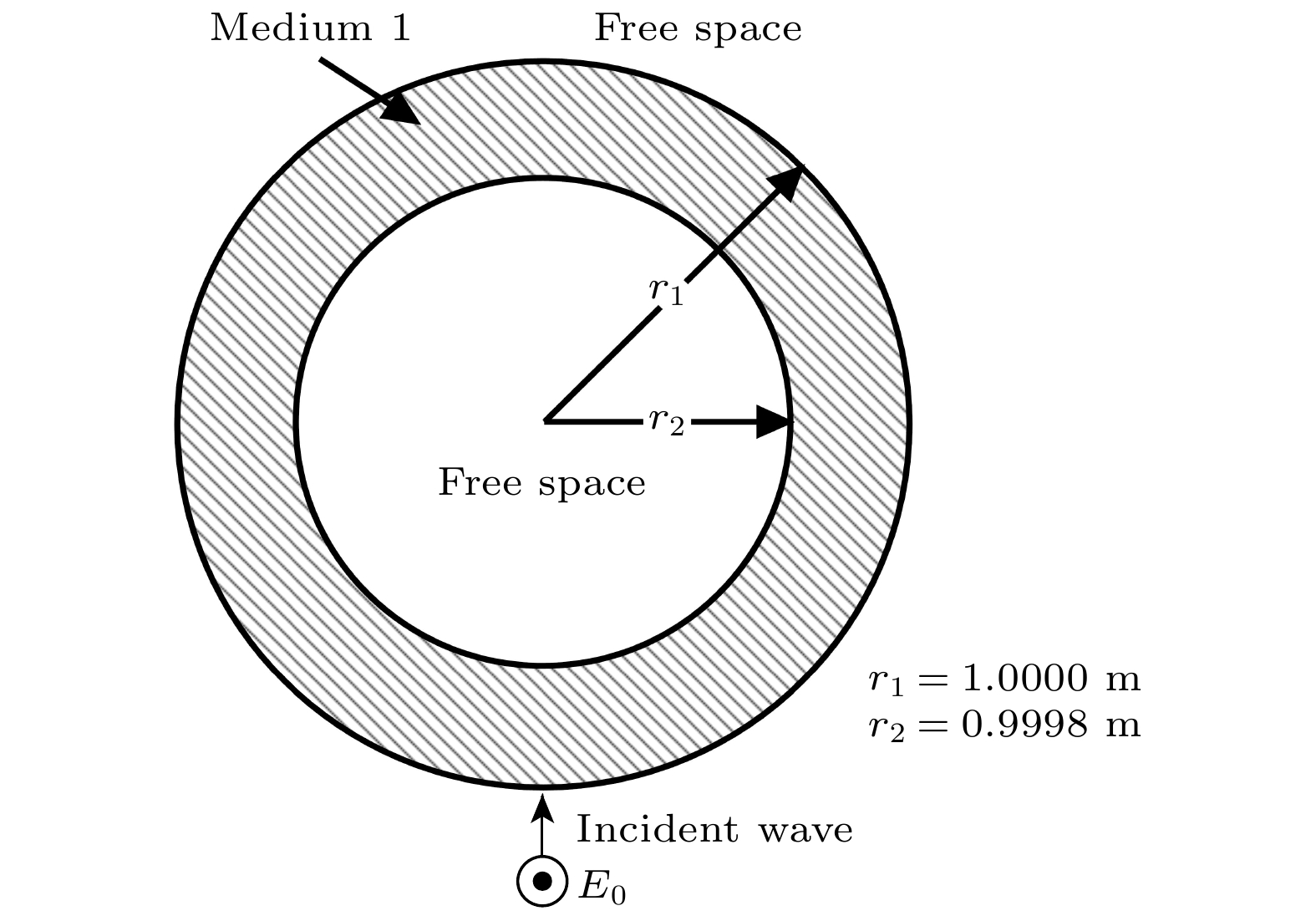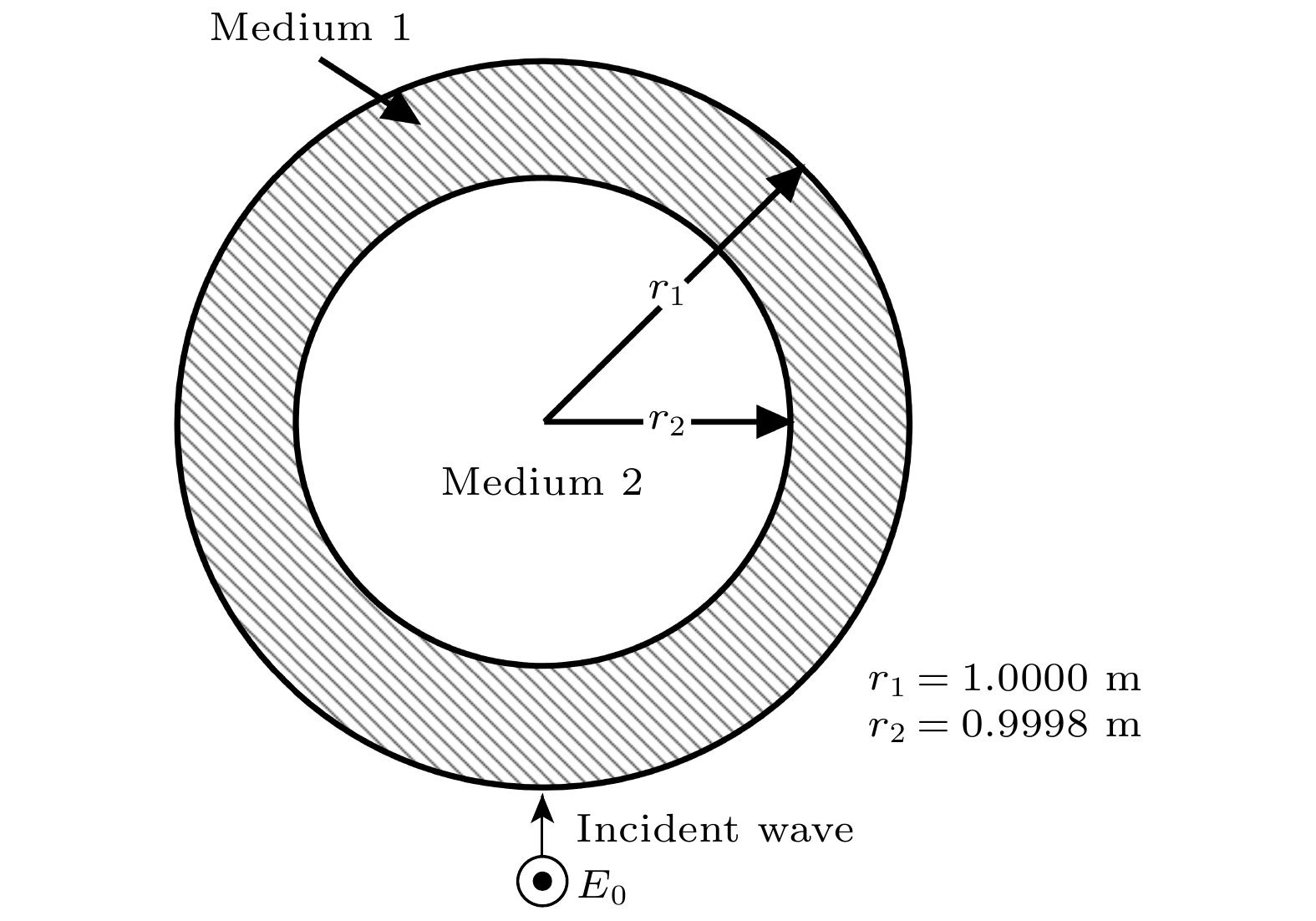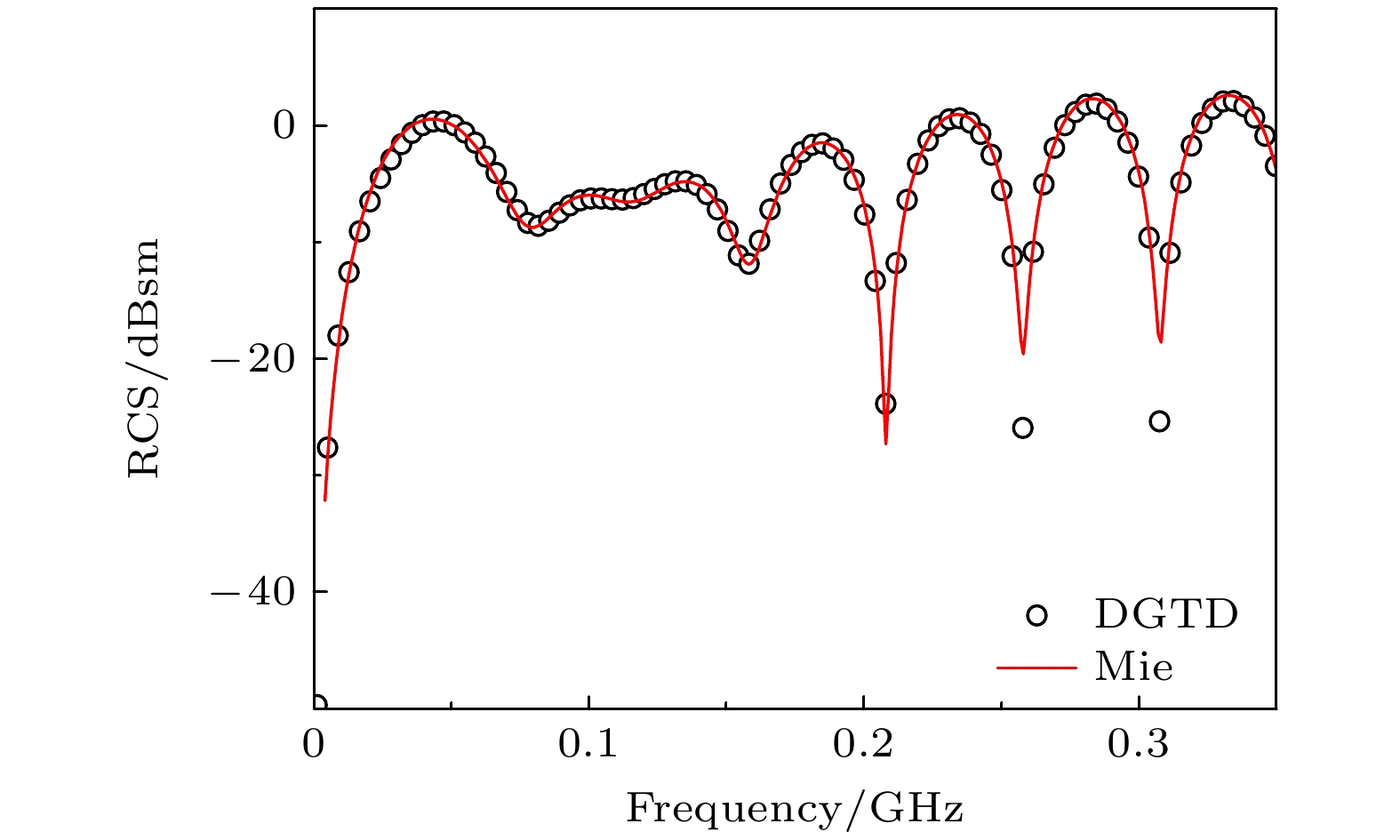-
本文研究了时域非连续伽略金算法(discontinuous Galerkin time-domain, DGTD)中的可穿透薄层问题, 薄层问题属于多尺度问题, 精确建模资源消耗太高难以实施, 可采用近似方案. 研究发现采用等效表面电流激励易产生发散, 为提高计算方案鲁棒性, 研究了电磁场修正方案, 这一方案允许采用参数很大的薄层(高介电系数), 其计算方法简便易行. 此外, 还给出了多层介质薄层的仿真方案, 并对相关数值算例进行验证, 结果说明了本文算法的精确性和有效性, 本文方案可用于复杂薄层电磁问题的快速求解.
-
关键词:
- 可穿透薄层 /
- 多尺度问题 /
- 时域非连续伽略金算法
The thin layer problem is common in some engineering cases, such as a coating target or dielectric radome. If the skin depth of the medium behind the thin layer is much smaller than the medium scale, the transmission line impedance boundary can be used to solve the thin layer problem . When both sides of the thin layer are free space or the skin depth of the medium behind the thin layer is greater than or comparable to the scale of the medium, the transmission line impedance boundary condition is not applicable. Such problems need incident and reflected wave data and are also known as penetrable thin-layer problems. When dealing with penetrable thin-layer problems, we need to give the electromagnetic wave data on both sides. In addition, the thin layer problem can belong with multi-scale problems. The EM simulation is difficult to implement because of the high resource consumption of accurate modeling. The accurate modeling is a very expensive algorithm, and the mesh-size difference between the thin layer region and the surrounding ordinary region is too large, thus seriously affecting the quality of the elements (tetrahedrons). So, it is difficult to solve the problem of thin layer quickly by using the time-domain discontinuous Galerkin method or even by using local time steps or other optimization methods. To acquire a fast solution, the approximate boundary condition can be used to describe the thin layer. The DGTD has also the advantage of the geometric fitting property. If a thin layer model is curved, we can build a conformal geometric model to deal with the thin layer, thus avoiding the complicated interpolation correction scheme. In this work, A robust DGTD method for penetrable thin layers is proposed. In our study, we find that the current excitation scheme is prone to divergence when large dielectric coefficients are dealt with and its robustness is poor. To solve this problem, we use the electromagnetic field correction scheme in DGTD to deal with the thin layer problems. In addition, engineering problems may encounter multiple thin layers. In this work, a simulation scheme for multiple thin layers is presented and relevant numerical examples are given to verify it. The results illustrate the accuracy and effectiveness of the method in this work, and the method presented in this work can be used for the fast calculation of complex thin layer problems. [1] Feliziani M 2011 IEEE Trans. Electromagn. Compat. 54 299
 Google Scholar
Google Scholar
[2] Hanson G W 2008 J. Appl. Phys. 103 064302
 Google Scholar
Google Scholar
[3] Shapoval O V, Gomez-Diaz J S, Perruisseau-Carrier J, Mosig J R, Nosich A I 2013 IEEE Trans. Terahertz Sci. Technol. 3 666
 Google Scholar
Google Scholar
[4] Maloney J G, Smith G S 1992 IEEE Trans. Antennas Propag. 40 323
 Google Scholar
Google Scholar
[5] Richmond J 1965 IEEE Trans. Antennas Propag. 13 334
 Google Scholar
Google Scholar
[6] Harrington R, Mautz J 1975 IEEE Trans. Antennas Propag. 23 531
 Google Scholar
Google Scholar
[7] Luebbers R J, Kunz K 1992 IEEE Trans. Antennas Propag. 40 349
 Google Scholar
Google Scholar
[8] Van den Berghe S, Olyslager F, De Zutter D 1998 IEEE Microw. Guided Wave Lett. 8 75
 Google Scholar
Google Scholar
[9] Schild S, Chavannes N, Kuster N 2007 IEEE Trans. Antennas Propag. 55 3587
 Google Scholar
Google Scholar
[10] Wang Y, Langdon S 2014 IEEE Antennas and Propagation Society International Symposium (APSURSI) Memphis, July 6–July 11, 2014 pp504–505
[11] Karlsson A 2009 IEEE Trans. Antennas Propag. 57 144
 Google Scholar
Google Scholar
[12] Nayyeri V, Soleimani M, Ramahi O M 2013 IEEE Trans. Electromagn. Compat. 56 385
 Google Scholar
Google Scholar
[13] Mi J, Ren Q, Su D 2020 IEEE Trans. Antennas Propag. 69 2230
 Google Scholar
Google Scholar
[14] Yang Q, Wei B, Li L, Ge D 2020 IEEE Trans. Antennas Propag. 69 3371
 Google Scholar
Google Scholar
[15] Ban Z G, Shi Y, Wang P 2021 IEEE Trans. Antennas Propag. 70 3916
 Google Scholar
Google Scholar
[16] Zhang T, Bao H, Gu P, Ding D, Werner D H, Chen R 2021 IEEE Trans. Antennas Propag. 70 526
 Google Scholar
Google Scholar
[17] Mitzner K 1968 IEEE Trans. Antennas Propag. 16 706
 Google Scholar
Google Scholar
[18] Li P, Shi Y, Jiang L J, Bağcι H 2015 IEEE Trans. Antennas Propag. 63 5686
 Google Scholar
Google Scholar
[19] Li P, Jiang L J, Bağcι H 2015 IEEE Trans. Antennas Propag. 63 3065
 Google Scholar
Google Scholar
[20] Li P, Jiang L J, Bağcı H 2018 IEEE Trans. Antennas Propag. 66 3590
 Google Scholar
Google Scholar
-
[1] Feliziani M 2011 IEEE Trans. Electromagn. Compat. 54 299
 Google Scholar
Google Scholar
[2] Hanson G W 2008 J. Appl. Phys. 103 064302
 Google Scholar
Google Scholar
[3] Shapoval O V, Gomez-Diaz J S, Perruisseau-Carrier J, Mosig J R, Nosich A I 2013 IEEE Trans. Terahertz Sci. Technol. 3 666
 Google Scholar
Google Scholar
[4] Maloney J G, Smith G S 1992 IEEE Trans. Antennas Propag. 40 323
 Google Scholar
Google Scholar
[5] Richmond J 1965 IEEE Trans. Antennas Propag. 13 334
 Google Scholar
Google Scholar
[6] Harrington R, Mautz J 1975 IEEE Trans. Antennas Propag. 23 531
 Google Scholar
Google Scholar
[7] Luebbers R J, Kunz K 1992 IEEE Trans. Antennas Propag. 40 349
 Google Scholar
Google Scholar
[8] Van den Berghe S, Olyslager F, De Zutter D 1998 IEEE Microw. Guided Wave Lett. 8 75
 Google Scholar
Google Scholar
[9] Schild S, Chavannes N, Kuster N 2007 IEEE Trans. Antennas Propag. 55 3587
 Google Scholar
Google Scholar
[10] Wang Y, Langdon S 2014 IEEE Antennas and Propagation Society International Symposium (APSURSI) Memphis, July 6–July 11, 2014 pp504–505
[11] Karlsson A 2009 IEEE Trans. Antennas Propag. 57 144
 Google Scholar
Google Scholar
[12] Nayyeri V, Soleimani M, Ramahi O M 2013 IEEE Trans. Electromagn. Compat. 56 385
 Google Scholar
Google Scholar
[13] Mi J, Ren Q, Su D 2020 IEEE Trans. Antennas Propag. 69 2230
 Google Scholar
Google Scholar
[14] Yang Q, Wei B, Li L, Ge D 2020 IEEE Trans. Antennas Propag. 69 3371
 Google Scholar
Google Scholar
[15] Ban Z G, Shi Y, Wang P 2021 IEEE Trans. Antennas Propag. 70 3916
 Google Scholar
Google Scholar
[16] Zhang T, Bao H, Gu P, Ding D, Werner D H, Chen R 2021 IEEE Trans. Antennas Propag. 70 526
 Google Scholar
Google Scholar
[17] Mitzner K 1968 IEEE Trans. Antennas Propag. 16 706
 Google Scholar
Google Scholar
[18] Li P, Shi Y, Jiang L J, Bağcι H 2015 IEEE Trans. Antennas Propag. 63 5686
 Google Scholar
Google Scholar
[19] Li P, Jiang L J, Bağcι H 2015 IEEE Trans. Antennas Propag. 63 3065
 Google Scholar
Google Scholar
[20] Li P, Jiang L J, Bağcı H 2018 IEEE Trans. Antennas Propag. 66 3590
 Google Scholar
Google Scholar
计量
- 文章访问数: 4019
- PDF下载量: 55
- 被引次数: 0














 下载:
下载:


